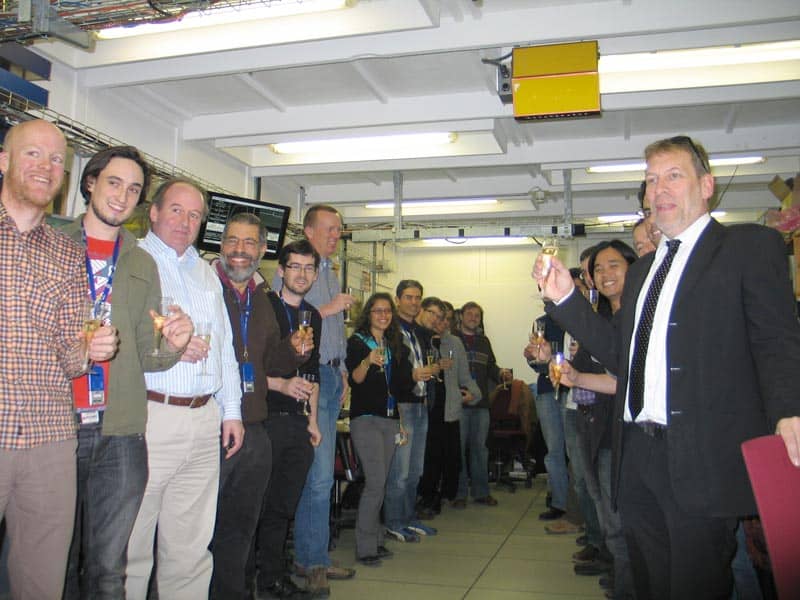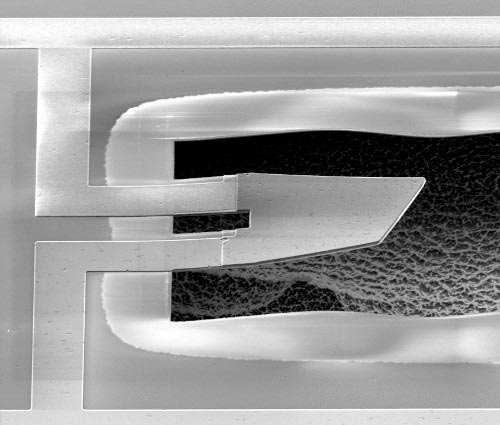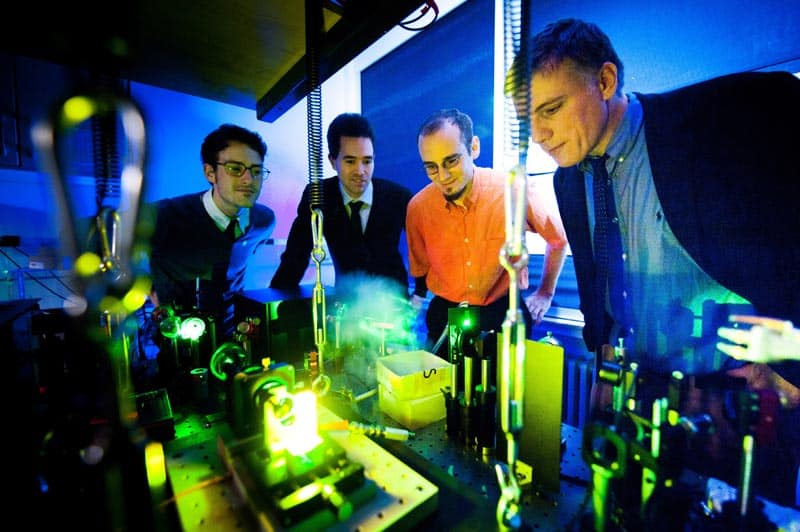It was a tough decision, given all the fantastic physics done in 2010. But we have decided to award the Physics World 2010 Breakthrough of the Year to two international teams of physicists at CERN, who have created new ways of controlling antiatoms of hydrogen.

The ALPHA collaboration announced its findings in late November, which involved trapping 38 antihydrogen atoms (an antielectron orbiting an antiproton) for about 170 ms. This is long enough to measure their spectroscopic properties in detail, which the team hopes to do in 2011.
Just weeks later, the ASACUSA group at CERN announced that it had made a major breakthrough towards creating a beam of antihydrogen that is suitable for spectroscopic studies. Our congratulations to both teams.
We have also awarded nine runners-up mentions (see below) – with second place going to the first direct detection of the spectrum of an exoplanet and third place to the observation of quantum behaviour in an object big enough to be seen with the naked eye.
1st place: Antihydrogen success
The antihydrogen breakthroughs scooped our first prize because it ought now be possible to carry out the first detailed studies of the energy levels in antihydrogen. Any slight differences in the levels compared to ordinary hydrogen could shed light on one of the biggest mysteries in physics – why there is so much more matter than antimatter in the universe.
The ALPHA group is represented by Jeffrey Hangst of Aarhus University in Denmark, who told physicsworld.com that the holy grail of antihydrogen studies is measuring the energy of the 1 s to 2 s atomic transitions. This transition in the far-ultraviolet has been measured in hydrogen to an accuracy of two parts in 1014, and making similar measurements on antihydrogen could reveal a violation of charge-parity-time reversal (CPT) symmetry. The discovery of such a violation could also help physicists understand why there is much more matter than antimatter in the universe.
One challenge facing the ALPHA team is accumulating enough antihydrogen to make accurate measurements – however, Hangst said that the team has already trapped “a lot” more than the 38 reported in November. Hangst says that the most difficult part of the five-year ALPHA project has been “learning how to make antihydrogen cold enough to trap”, because it is extremely difficult to make spectroscopic studies on beams.
In December, however, the ASACUSA team announced its ability to create a focused beam of antihydrogen that the researchers believe is suitable for making spectroscopic measurements at microwave energies. This should allow them to look at the hyperfine structure of antihydrogen energy levels and compare them to hydrogen – which could provide evidence of CPT violation.
ASACUSA team leader Yasunori Yamazaki of the RIKEN laboratory in Japan told physicsworld.com that its next step is to make their “antihydrogen beam from a strong non-uniform magnetic field region where it is produced and into a microwave cavity for analyses in a magnetic-field-free region to realize high-precision spectroscopy”. He adds that the physicists are “an inch away” from extracting the beam and “several inches away” from making spectroscopic measurements. “I hope we can start to work on the spectroscopy next year after the confirmation of an antihydrogen beam,” he says.
Perhaps the most exciting aspect of both projects is that there is no definitive theoretical prediction of how (or indeed if) CPT-violation will occur in the hydrogen-antihydrogen system. The antihydrogen experiments will begin again at CERN in May, so look forward to exciting results – and perhaps a few surprises from both groups.
2nd place: Exoplanet atmosphere laid bare
Second place in our list of top breakthroughs for 2010 goes to a team of astronomers in Canada and Germany who have made the first direct measurement of the atmospheric spectrum of a planet outside our solar system. Markus Janson of the University of Toronto and colleagues used the European Southern Observatory (ESO) Very Large Telescope (VLT) to study the atmosphere of the exoplanet HR 8799, which is 130 light-years from Earth. Although this particular exoplanet shows no signs of life, the ability to make such measurements is an important step forward in the search for life elsewhere in the universe.
3rd place: Quantum effects seen in a visible object
In what is an important step towards testing Schrödinger’s cat paradox, physicists at the University of California, Santa Barbara have bagged third place in our top 10 by observing true quantum behaviour in a macroscopic object big enough to be seen with the naked eye. Andrew Cleland and crew reduced the amplitude of the vibrations in a resonator by cooling it down to below 0.1 K. They were then able to create a superposition state of the resonator where they simultaneously had an excitation in the resonator and no excitation in the resonator. “This is analogous to Schrödinger’s cat being dead and alive at the same time,” says Cleland. This is the first time this feat has been achieved and it could shed light on the mysterious boundaries between the classical and quantum worlds.
4th place: Visible-light cloaking of large objects
Fourth place on our list is a last-minute entry and goes to two independent teams of physicists who have just published preprints claiming to have built the first invisibility cloaks that can hide large objects from visible light. Now George Barbastathis and colleagues at the Massachussets Institute of Technology and the University of Singapore report the cloaking of 2D millimeter-sized objects. Meanwhile Shuang Zhang and team at the University of Birmingham, Imperial College and the Technical University of Denmark have managed to cloak millimeter-sized 3D objects from prying eyes. Unlike most other cloaks that use artificial metamaterials, both cloaks use natural calcite crystals.
5th place: Hail the first sound lasers
Two independent groups of physicists have been jointly awarded fifth place after they unveiled the first phonon “lasers”. These emit coherent sound waves in much the same way as lasers emit coherent light waves. One team was led by Tony Kent at the University of Nottingham in the UK and the other by Ivan Grudinin at Caltech. One of the devices emits sound at about 400 GHz while the other operates in the megahertz range. As sound penetrates most materials, the lasers could be used to obtain 3D images of tiny nanostructures.
6th place: A Bose–Einstein condensate from light
Many physicists believed it could not be done, but now a team in Germany has created a Bose–Einstein condensate (BEC) from photons, earning them the sixth slot. BECs are formed when identical bosons – particles with integer spin – are cooled until all particles are in the same quantum state. Although photons are the most common boson of them all, they are easily created or destroyed when they interact with other matter – making it very difficult to cool photons to form a condensate. But that did not deter Martin Weitz and colleagues at the University of Bonn, who got round this problem by continuously pumping the BEC with a laser to make up for lost photons. Beyond the pure chutzpah of making the BEC, the breakthrough could actually help boost the performance of solar cells.
7th place: Relativity with a human touch
Seventh place in our league table goes to physicists in the US who have shown us the human face of relativity. James Chin-Wen Chou and colleagues at the National Institute of Standards and Technology (NIST) used two of the world’s most accurate optical clocks to show that time speeds up in a clock that is hoisted a mere 33 cm above the other. They also saw time slow down in a clock moving less than about 35 km/h relative to its twin. While there’s nothing groundbreaking about the physics – Einstein’s theories of relatively are on very solid ground – it’s reassuring that its effects can be seen at human distances and speeds.
8th place: Towards a Star Wars telepresence
Anyone who uses physics to realize a scene from Star Wars deserves a place in our top 10, which is why Nasser Peyghambarian and collegues at the University of Arizona and Nitto Denko Technical Corporation come in at number eight. In 1977 audiences were wowed by the special effects in that cinematic classic, which included a hologram of Princess Leia making a distress call to Obi-Wan Kenobi. Now, Peyghambarian and team have taken a big step towards making such real-time, dynamic holograms a reality by inventing a photorefractive polymer screen that reacts very quickly to laser light.
9th place: Proton is smaller than we thought
Physicists have been making measurements of protons for more than 90 years so you would have thought its size would be settled. But this year an international team led by Randolf Pohl at the Max Planck Institute for Quantum Optics discovered that the proton is about 4% smaller than previously thought – bagging ninth place in our list. The surprising result was obtained by studying “muonic” hydrogen in which the electron is replaced by a much heavier muon. The finding could mean that physicists need to rethink how they apply the theory of quantum electrodynamics (QED) – or even that the theory itself needs a major overhaul.
10th place: CERN achieves landmark collisions
We couldn’t have a top 10 list that does not include the significant breakthroughs in accelerator technology at CERN’s Large Hadron Collider (LHC). In March, LHC physicists achieved the first 7 TeV proton–proton collisions ever achieved in a particle accelerator. And what’s more, in November the LHC moved seamlessly into the business of colliding lead ions in a successful bid to recreate the conditions of just after the Big Bang. Both runs generated copious amounts of data that will keep physicists busy until the accelerator starts up again next year.









